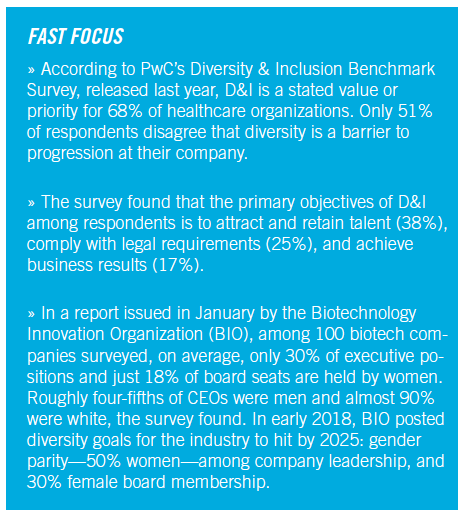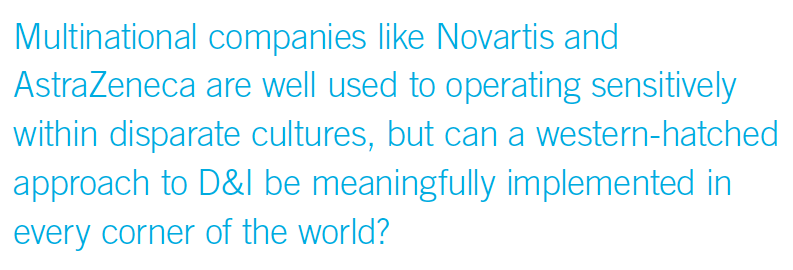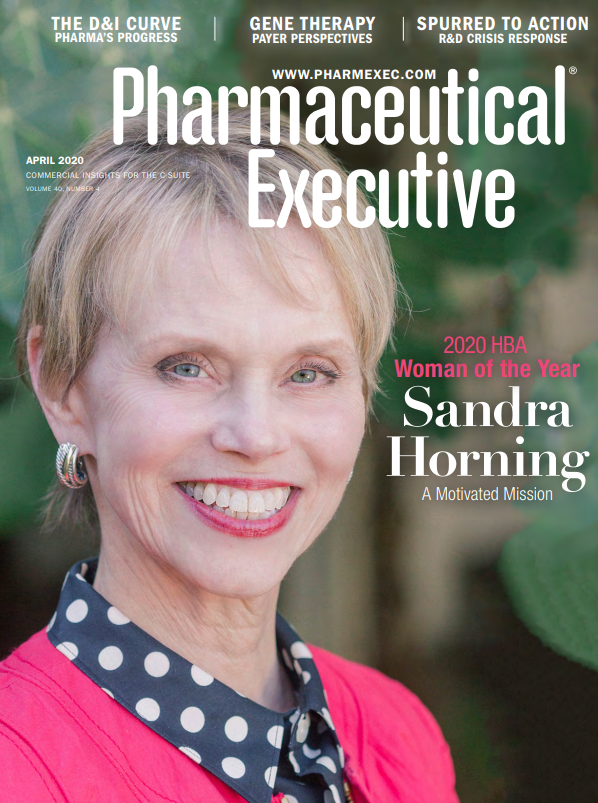Doubling Down on D&I
Pharmaceutical Executive
Recognizing that diversity and inclusion is no longer simply a “nice to have,” pharma has boosted efforts in this areas. But just how far are new industry initiatives moving the needle on D&I?
Exploring just how far new industry initiatives and strategies are pushing the needle on diversity and inclusion in pharma
In the last decade or so, the issue of diversity and inclusion (D&I) has advanced steadily within the life sciences discourse, its growing prominence reflected in the job titles that have emerged at senior levels among the front rank of pharma companies. The industry now boasts heads of diversity & inclusion, chief diversity officers, and corporate leads in D&I, culture, and engagement. To convey the message that D&I is no longer simply regarded as a “nice to have,” or approached as an add-on to existing anti-discriminatory compliance, the industry has boosted its efforts from hiring policies to media campaigns. But the argument persists that pharma is well behind the curve when it comes to realizing its D&I goals, particularly at the senior and board levels, where women remain under-represented (and where people from ethnic and racial minorities remain very under-represented). As this journey toward achieving real balance and representation goes on,
Pharm Exec
spoke to leading D&I exponents from two big pharmas (Novartis and AstraZeneca) and consultants with long experience of recruiting emerging leadership talent to see how far the latest industry initiatives are moving the needle on D&I. “Our inclusion and diversity strategy has been essential in ensuring we keep our collective efforts focused,” Rebekah Martin, SVP, Reward and Inclusion at AstraZeneca, told
Pharm Exec
. She reports “significant strides” in the company’s D&I activities, with D&I now established as one of the three pillars of its People strategy, which “has helped us to embed inclusive behavior and leadership throughout the company.” She goes on to outline the recent recognition AZ has received for its D&I efforts. “We were one of 325 companies selected for this year’s Bloomberg Gender-Equality Index, which distinguishes companies committed to transparency in gender reporting and advancing women’s equality,” says Martin. “We earned a 100 on the Human Rights Campaign’s index to designate AstraZeneca one of the 2020 Best Places to Work for LGBTQ Equality. [And] last year’s Hampton-Alexander Review named AZ plc as one of the top 10 best performers in the FTSE 100 for representation of women on the combined executive committee and their direct reports.”
Over at Novartis, Vice President and US Country Head, Diversity and Inclusion, Marion Brooks says he has seen a lot of progress during his 20-plus years with the company. “The level of focus has definitely grown
Marion Brooks

around D&I,” he told Pharm Exec. It is now “a fundamental part of Novartis’ cultural aspirations, as well as its strategic priorities.” The company has established three global strategic imperatives: “diverse people, inclusive environment, and shaping our society,” says Brooks, under which there are six initiatives: gender balance in management; pay equity and transparency; attracting and retaining diverse talent; creating inclusive learning offerings for everyone; LGBTI equity; and strengthening employee resources groups (ERGs).
The latter, particularly, play a major role in the pursuit of improved D&I. Novartis has over 60 ERGs globally which, according to Brooks, “really help us to support the values and behaviors, as well as the business codes, of our organization.” Before taking his current position, Brooks spent 20 years on the commercial side of Novartis, but during that time he was heavily involved with ERGs, leading one for a number of years. “ERGs help to foster a level of belonging between the organization and its associates and drive our inspired, curious, and unbossed culture,” he explains.
AstraZeneca has upwards of 15 ERGs worldwide, led by volunteers. They play an important role, says Martin, “in continuing the dialogue throughout the year, keeping our efforts aligned to our business strategy, and providing capabilities to drive forward our inclusion and diversity strategy.” One example is AZ’s SAFE
Click to enlarge

SPACE ERG, which has been “hugely successful” in supporting colleagues and improving the dialogue around mental health. Another ERG, which originated from AZ employees, is AZPride. Last year, AZPride ran the “This is Me” campaign, which saw employees sharing their stories of coming out and their experiences as a member or ally of the LGBT+ community. “These powerful stories,” says Martin, “were spread internally and externally through our social media platforms throughout Pride month and provided education and an opportunity to connect across the organization.”
Global reach
While these D&I initiatives can be very effective in addressing issues that affect an increasingly diverse workforce, there is something of a first-world sensibility to many of them. Multinational companies like Novartis and AZ are well used to operating sensitively within disparate cultures-this in itself requires diverse and inclusive thinking- but can a western-hatched approach to D&I be meaningfully implemented in every corner of the world?
Brooks believes so, and says it’s important for Novartis to make a global impact in this way. Over the last decade, he explains, D&I has become more of a global function and a globally aligned strategy at Novartis. “It’s a part of everything that we do, and it should show in our day-to-day actions,” he says. “We have over 108,000 associates and we operate in over 100 countries, so we have a huge opportunity to help to effect change across the globe.” One example is taking a stance on global topics such as equal pay. “Those are opportunities for us

not only to influence and impact our associates but also to help shape the reality of the individuals in the countries where we operate,” says Brooks.
Martin asserts that a global approach to D&I is achievable with the “right framework in place.” Last year, AZ launched its Global Inclusion and Diversity Council. Chaired by AZ’s CEO, Pascal Soriot, it “has enabled us to set the tone from the top,” says Martin. The Council includes representatives from each of the senior executive team areas and key geographies, and its “outputs have been really effective as we now have a global approach that is locally relevant.” The company also has a Global Standard for Inclusion and Diversity, “which sets out how we foster an inclusive and diverse workforce where everyone feels valued and respected because of their individual ability and perspective,” adds Brooks.
Certainly, AZ appears active in promoting its global D&I efforts. In 2018, it held a crowdsourcing event to help shape the next phase of its strategy, with employees across the world contributing to the activity and generating more than 56,000 ideas, according to the company. Last year, for the first time, AZ held eight “Empowerment Summits” across the US, Asia-Pacific, Brazil, Sweden, Poland, and the UK. “While the approach is global, all of the content is curated by local teams to ensure it is relevant and effective,” explains Martin. “They were so successful that we have plans for expansion to other countries this year.”
Diversity and disruption
Pharma companies’ D&I web pages are filled with inspiring copy, but it can be more sobering to compare the sector’s position on the diversity curve with that of smaller biotechs (and other advanced industries). While the recent BIO report, Measuring Diversity in the Biotech Industry, highlighted areas where the biotechnology sector requires major improvement-for example, 88% of the companies responding to the survey had a white, male CEO and only 16% reported having goals to promote or develop women-it also pointed to an emerging trend whereby startup businesses “are generally better than their larger counterparts at recognizing the value of diversity,” says Chris Coe, executive vice president of Talentmark.
“In the report, pre-revenue, smaller, and private companies all showed positive outcomes for representation,” he told Pharm Exec, pointing to findings that show pre-revenue organizations are more likely than profitable organizations to have executive levels that are at least 25% people of color; small businesses are more than twice as likely to have a female CEO, compared with larger companies; and privately held organizations are more than three times as likely to have a person of color as CEO.
“These results may seem unfairly skewed for big pharma,” adds Coe, but “it can be far easier for fledgling businesses to establish a culture of inclusiveness and attract a more diverse workforce.”
Katy Wallace, principal consultant in the life sciences practice at Berwick Partners, observes that “the entry points in the smaller businesses are better for more diverse candidates, because they tend to be more able and willing to challenge the status quo-this is a key factor in improving and championing diversity.” She explains:
Katy Wallace

“Big pharma is definitely moving in the right direction, but progress is slower than we see in some sectors. Some feel that this redefinition of what leadership looks like hasn’t resonated enough in the larger organizations, but it is more of a challenge in pharma to change quickly as so much of the hiring at grass roots is dependent on education. However, when this barrier of entry is removed, unconscious bias is also removed, people are then weighed and measured more fairly on their skills, which allows for a more diverse candidate pool.”
As big pharma is cash rich, change is typically driven by a need to change, which can be down to loss of revenue or legal implications, says Wallace. So that pressure for diversity hasn’t been as strong or as visible as it is now in big pharma. “It is being addressed for sure, and there are some wonderful initiatives in place,” she says. “However, the problem I see with candidates coming up through the ranks is that they don’t feel the speed of change is sufficient and, therefore, will look to work with businesses they feel are more adaptive and action-orientated when it comes to addressing diversity.”
An area where life sciences as a whole is now starting to struggle and, therefore, is going to have a “real problem” in the future is initial grass-roots attraction, notes Wallace. “We will struggle to get these people through the door.” The industry, she says, should be trying to do more to work with schools, particularly disadvantaged schools, which don’t have the resources or the teaching power, to help push students through the STEM subjects.
At the university level, the industry should be helping to make sure candidates don’t drop out of their field of study. Wallace welcomes all initiatives going on within life sciences businesses to encourage a more diverse and inclusive culture, not least the creation of a chief inclusion officer, “which denotes a real desire of the boards to make meaningful change in this area.”
But, she adds, “the industry also needs to be looking at what it can be doing outside of businesses, in the community at entry level.”
Tipping the gender-balance
While, in Wallace’s opinion, pharma seems to have been misguided in considering diversity as a gender issue alone, she notes that pharma initially made outstanding progress in areas such as increasing female representation on boards. But in recent years this progress has slowed down somewhat. “There may have been a bit of complacency, with some of the bigger businesses saying, ‘Okay, we’ve got one woman on the board now, that’s great.’ The problem is, what happens when that woman leaves, and the board goes back to zero female representation, which unfortunately has happened? No one was looking at that.”
Wallace notes that if an organization has more female leadership, it’s proven that the sense of inclusiveness filters down through the company, and that’s not just an increase in female leaders, but leaders from racial and ethnic minorities too. It’s also been proven, she says, that more diversity heeds better operational results and share performance that is being recognized by some of the industry’s leading businesses. But it doesn’t necessarily rely on a “top-down” approach. “How do you get women and diverse candidates into those positions in the first place? Eighty percent of directors are male,” notes Wallace. “Progress needs to come from

the bottom-up, because your pull of leadership comes from underneath; it comes from succession and how can a business promote diversity at board level; if it lacks the numbers lower down, it becomes an impossible fight for the boards.”
Wallace does say, however, that “the gender-balance conversation is starting again.” She is hopeful that the sector will change over the coming months and years. “We do have more female/diverse leaders, so we’ve got more female/diverse influencers across the industry, which keeps the conversation alive.”
AZ’s Martin reports that the organization improved female representation at management levels from 39% in 2012 to 45.4% in 2019. And at Novartis, “right now, 44% of our managers are female, and overall, 50% of our workforce is female,” says Brooks. “As the statistics improve,” says Wallace, “we’ll be able to see the positive effects a truly diverse and inclusive culture has on bottom-line profit, which hopefully, in turn, will continue to drive more diversity.”
Business values
Martin agrees that her organization’s D&I work “is far from done.” She stresses, though, that AZ is always striving to achieve more. The company’s recent external activities, for example, include joining the United Nations Free and Equal Standards for Business-aimed at tackling discrimination against LGBTI people-and committing to the United Nations Women’s Empowerment Principles dedicated to corporate actions to endorse equality.
As for Novartis, of its six D&I initiatives, pay equity and transparency is to be executed and rolled out in the US in June, and gender balance in management is “a goal for us by 2023,” says Brooks. He adds that the company has implemented new hiring guidelines that address female as well as ethnic and racial diversity in the US, and has hired a D&I scouting and recruiting team for the first time “to help us to engage with diverse communities and to build a pipeline of diverse talent.”
Like other organizations, AZ and Novartis have also reached an understanding of D&I’s “strategic and economic” importance to their businesses. Key to D&I’s wider acceptance and implementation is its growing impact on the bottom line. “D&I has become a competitive advantage,” says Brooks. “The data show that diverse organizations and teams deliver three things that more homogenous teams do not: higher revenue, more innovation, and they are more responsive to customer needs. Whether you’re a little league team or a major corporation, you want to deliver on those three benefits.”
At AZ, Martin believes there’s no doubt that “having an inclusive and diverse workforce was pivotal to our success in returning to growth and essential for our success today.” Bringing together different ways of thinking, she adds, is “the foundation of the company’s ability to innovate, which is a differentiator for us and has propelled our growth at an individual and company level.”
Martin is keen to emphasize, however, that business growth is not the main goal of D&I. “It’s just as important that we are doing the right thing and nurturing a values-based culture where we can all enjoy coming to work every day.”
Julian Upton is Pharm Exec’s European and Online Editor. He can be reached at jupton@mjhlifesciences.com
